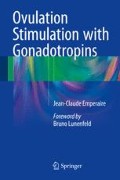Abstract
The ovary is hardly an isolated organ. It is not only unique to each patient; it is subject to numerous intrinsic and extrinsic factors of the patient’s health and disease, as well as to personal and psychosocial environments.
Access this chapter
Tax calculation will be finalised at checkout
Purchases are for personal use only
References
Dobbs KE, Dumesic JA, Shapiro SS (1994) Differences in serum follicle-stimulating hormone uptake after intramuscular and subcutaneous human menopausal gonadotropin injection. Fertil Steril 62:978–983
Pantasri T, Norman RJ (2014) The effects of being overweight and obese on female reproduction: a review. Gynecol Endocrinol 30:90–94
Koning AM, Mutsaerts MA, Kuchenbecker WK et al (2012) Complications and outcome of assisted reproductive technologies in overweight and obese women. Hum Reprod 27:457–467
Clark AM, Ledger W, Galletly C et al (1995) Weight loss results in significant improvement in pregnancy and ovulation rates in anovulatory obese women. Hum Reprod 10:2705–2712
Cheang KI, Nestler JE (2004) Should insulin-sensitizing drugs be used in the treatment of polycystic ovary syndrome? Reprod Biomed Online 8:440–447
Wenhong M, Zhongping Z, Xiaoyan L et al (2013) Subclinical impairment of ovarian reserve in systemic lupus erythematous patients with normal menstruation not using alkylating therapy. J Women Health (Larchmt) 22(12):1023–1027
Block E (1952) Quantitative morphological investigation of the follicular system in women: variations at different ages. Acta Anat 14:108–123
White Y, Woods DC, Yashushi-Takai I et al (2012) Oocyte formation by mitotically active germ cells purified from ovaries of reproductive-age women. Nat Med 18:413–421
Luna M, Grunfeld L, Mukherjee T et al (2007) Moderately elevated levels of basal follicle-stimulating hormone in young patients predict low ovarian response, but should not be used to disqualify patients from attempting in vitro fertilization. Fertil Steril 87:782–787
Toner JP (2003) Age = egg quality, FSH level = egg quantity. Fertil Steril 79:491
Merviel P, Lourdel E, Cabry R et al (2009) L’exploration de la réserve ovarienne dans le bilan d’infertilité. La Lettre du Gynécologue 343:31–36
Netter A, Salomon Bernard Y, Millet D (1968) Test de stimulation ovarienne par les HMG. In: Les Gonadotrophines d’Origine Humaine. Byla-Sarle Ed, Paris, pp 31–41
Wunder DM, Bersinger NA, Yared DM et al (2008) Statistically significant changes of anti-Müllerian hormone and inhibin levels during the physiologic menstrual cycle in reproductive age women. Fertil Steril 89:927–933
Bottcher B, Tsybulyak I, Grubinger T et al (2013) Dynamics of anti-Müllerian hormone during controlled ovarian stimulation. Gynecol Endocrinol 30:121–125
Fanchin R, Schonauer LM, Gighini C et al (2003) Serum anti-Mullerian hormone is more strongly related to ovarian follicular status than serum inhibin B, estradiol, FSH and LH on day 3. Hum Reprod 18:323–327
Han X, McShane M, Sahertian R et al (2014) Pre-mixing serum samples with assay buffer is a prerequisite for reproducible anti-Müllerian hormone measurement using the Beckman Coulter Gen II assay. Hum Reprod 29:1042–1048
Berwanger DA, Silva AL, Even M et al (2010) Hormone antimullerienne: acteur et marqueur de la folliculogènese. Gynecol Obstet Fertil 38:471–474
Tanprasertkul C, Manusook S, Somprasit C et al (2014) Antimullerian hormone changes after laparoscopic ovarian cystectomy for endometrioma compared with the nonovarian conditions. Minim Invasive Surg 2014:654856
Chan C, Liu K (2014) Clinical pregnancy in a woman with idiopathic hypothalamic hypogonadisme and low AMH: utility of ovarian reserve markers in IHH. J Assist Reprod Genet 31(10):1317–1321
Loh JS, Maheshwari A (2011) Anti-Mullerian hormone – is it a crystal ball for predicting ovarian aging? Hum Reprod 26:2925–2932
Hall JE, Welt CK, Cramer DW (1999) Inhibin A and inhibin B reflect ovarian function in assisted reproduction but are less useful at predicting outcome. Hum Reprod 14:409–415
Dewailly D, Gronier H, Poncelet E et al (2011) Diagnosis of polycystic ovary syndrome (PCOS): revisiting the threshold values of follicle count on ultrasound and the serum AMH levels for the definition of polycystic ovaries. Hum Reprod 26:3123–3129
Muttukrishna S, Mc Garrigle H, Wakim R et al (2005) Antral follicle count, anti-Müllerian hormone, and inhibin B: predictors of ovarian response in assisted reproductive technology? BJOG 112:1384–1390
Klinkert ER, Broekmans F, Looman CV et al (2005) The antral count is a better marker than basal follicle-stimulating hormone for the selection of older patients with acceptable pregnancy prospects after in vitro fertilization. Fertil Steril 83:811–814
Syrop CH, Dawson JD, Husman KJ et al (1999) Ovarian volume may predict assisted reproductive outcomes better than follicle stimulating hormone concentration on day 3. Hum Reprod 14:1752–1756
Tremellen K, Savulescu J (2014) Ovarian reserve screening: a scientific and ethical analysis. Hum Reprod 29:2606–2614
Illiodromiti S, Anderson RA, Nelson SM (2014) Technical and performance characteristics of anti-Müllerian hormone and antral follicle count as bio- markers of ovarian response. Hum Reprod Update. Epub on 11 June 2015
Author information
Authors and Affiliations
Rights and permissions
Copyright information
© 2015 Springer International Publishing Switzerland
About this chapter
Cite this chapter
Emperaire, JC. (2015). In Preparation for the Stimulation. In: Ovulation Stimulation with Gonadotropins. Springer, Cham. https://doi.org/10.1007/978-3-319-18654-2_4
Download citation
DOI: https://doi.org/10.1007/978-3-319-18654-2_4
Publisher Name: Springer, Cham
Print ISBN: 978-3-319-18653-5
Online ISBN: 978-3-319-18654-2
eBook Packages: MedicineMedicine (R0)

